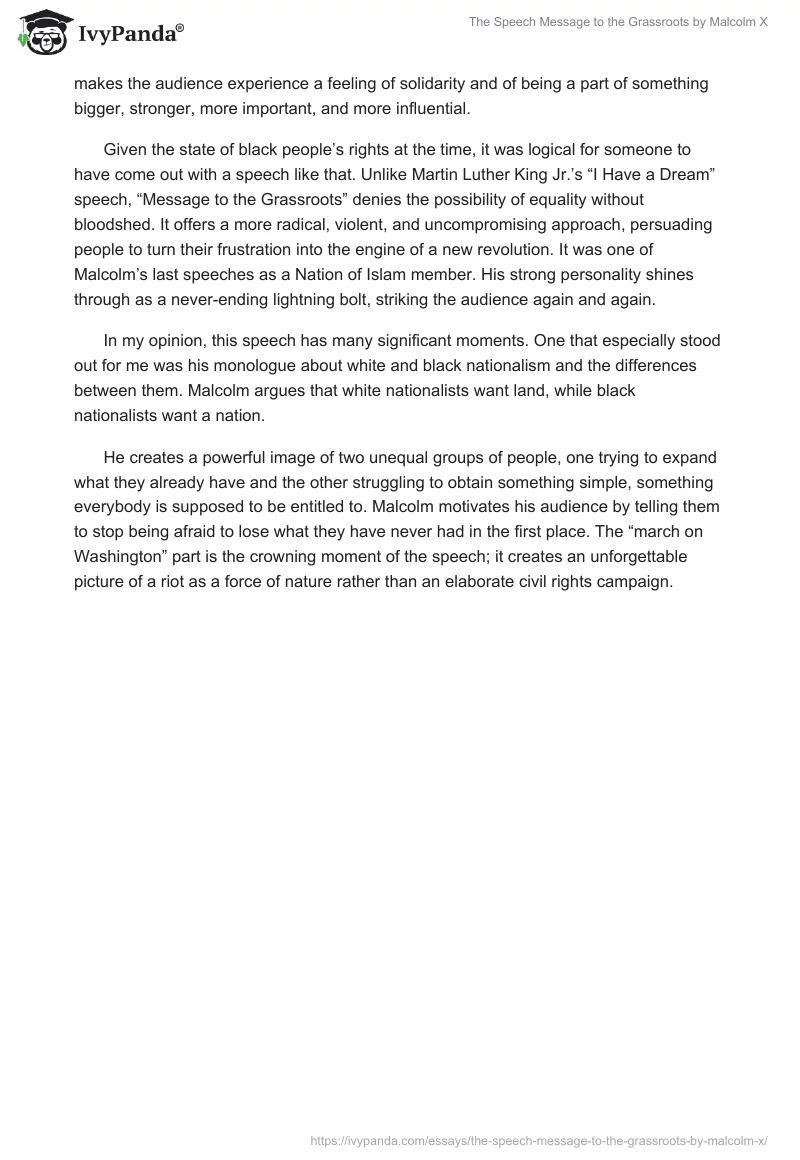This speech was delivered on November 10, 1963, at a time when black people struggled fiercely against the racism of modern society to claim their basic human rights. In his speech, Malcolm constantly points out that no matter how liberated black people have become over the past decades, they are still nothing but “second-class citizens” and “ex-slaves” to white people. He repeatedly calls upon the audience to join a revolution to defeat the common enemy of white oppression.
He also explains the difference between the “Black Revolution” (one that is violent and based on land) and the “Negro Revolution” (one that is nonviolent and based on overcoming differences peacefully), insisting that a real revolution can never avoid violence. He encourages his listeners to stick together and start a real revolution, without tolerance and without “turning the other cheek.”
The audience’s response is admittedly enthusiastic: people are cheering, whistling, clapping, laughing, and booing, depending on Malcolm’s statements throughout the speech. If we look closely, we see that Malcolm is using certain oratorical devices to keep his audience listening and reacting. His speech is filled with examples, analogies, colorful historical remarks, and vivid imagery that grabs the listeners’ attention and keeps it in place, frequently invoking sounds of approval.
He juxtaposes long, thoughtful sentences with shorter, straight-to-the-point ones, which breaks information down into sections and makes the whole message easier to comprehend. For example, his tale about house and field Negroes and slave masters generates massive waves of cheering. People can relate and agree; therefore, they encourage the speaker to continue. When Malcolm says that a revolution without violence is impossible, it makes people cheer and clap even more, sounding energized and resolved. Such words give them confidence and make them feel stronger at a given moment, prompting these powerful reactions.
When Malcolm refers to black people as a big family and when he constantly repeats the word “common” in regards to the white man as the common enemy, he makes the audience experience a feeling of solidarity and of being a part of something bigger, stronger, more important, and more influential.
Given the state of black people’s rights at the time, it was logical for someone to have come out with a speech like that. Unlike Martin Luther King Jr.’s “I Have a Dream” speech, “Message to the Grassroots” denies the possibility of equality without bloodshed. It offers a more radical, violent, and uncompromising approach, persuading people to turn their frustration into the engine of a new revolution. It was one of Malcolm’s last speeches as a Nation of Islam member. His strong personality shines through as a never-ending lightning bolt, striking the audience again and again.
In my opinion, this speech has many significant moments. One that especially stood out for me was his monologue about white and black nationalism and the differences between them. Malcolm argues that white nationalists want land, while black nationalists want a nation.
He creates a powerful image of two unequal groups of people, one trying to expand what they already have and the other struggling to obtain something simple, something everybody is supposed to be entitled to. Malcolm motivates his audience by telling them to stop being afraid to lose what they have never had in the first place. The “march on Washington” part is the crowning moment of the speech; it creates an unforgettable picture of a riot as a force of nature rather than an elaborate civil rights campaign.


